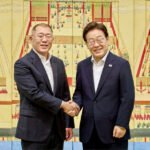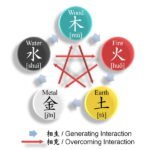Introduction: The Geopolitical Significance of Korea
Korea’s geographical location in East Asia has rendered it a pivotal player in the region’s historical dynamics. This peninsula, bordered by the Yellow Sea to the west, the Japan Sea to the east, and the Korea Strait to the south, sits strategically between two major world powers: China and Japan. Due to this positioning, Korea has often acted as a cultural and economic bridge, facilitating exchanges and interactions between these neighboring countries throughout history.
The significance of Korea’s role has evolved over the centuries. During ancient times, the Korean territories were crucial for the transmission of ideas and goods between China and Japan, particularly in areas such as agriculture, religion, and technology. The influence of Confucianism and Buddhism, which traveled from China to Japan via Korea, illustrates the peninsula’s function as a conduit for cultural diffusion. This relationship allowed Korea to maintain its unique identity while simultaneously being molded by its powerful neighbors.
The late 19th and early 20th centuries marked a period of significant change as Western powers, driven by imperial ambitions, began to engage more actively in East Asian affairs. Korea found itself at the crossroads of competing influences, as Russia and Japan vied for control over the Korean Peninsula, leading to conflicts that would shape the region’s future. As Korea navigated these complex relationships, its geopolitical importance continued to grow, drawing the attention of global superpowers keen to assert their dominance in the region. Understanding this backdrop is essential in assessing Korea’s historical diplomacy and its evolving interactions with global powers, which set the stage for contemporary international relations.
Ancient Korea: Early Connections with China
Exploring Ancient Korea: A Journey into Pre-History – Open Korea
The history of Korea is intricately intertwined with that of China, with connections dating back to ancient times. These early interactions laid the foundation for cultural exchanges, trade, and the dissemination of ideas that profoundly shaped Korean society. During the early dynastic periods in Korea, particularly the Three Kingdoms of Goguryeo, Baekje, and Silla, the influence of Chinese civilization became increasingly pronounced. The proximity of Korea to various Chinese dynasties fostered a dynamic relationship characterized by admiration and adaptation.
Trade routes established between Korea and China facilitated not only the exchange of goods but also a transfer of knowledge and cultural practices. Korean artisans and scholars were influenced by their Chinese counterparts, leading to the adoption of Chinese writing systems and artistic styles. One of the most noteworthy impacts from China was the introduction of Confucianism, which profoundly influenced Korean governance, social structure, and familial relationships. Confucian ideals became foundational to Korean identity, shaping societal norms and values.
Additionally, Buddhism found its way into Korea from China during the early centuries of the Common Era, bringing with it new spiritual perspectives and artistic traditions. The establishment of Buddhist temples and the promotion of Buddhist practices signified a shift in religious landscape that harmonized with existing belief systems. This integration of Buddhism complemented the Confucian ideas already taking root, leading to a distinctive blend of philosophical and spiritual thought that has persisted throughout Korean history.
Throughout these ancient exchanges, Korea maintained a unique cultural identity while adapting and integrating the influences from Chinese dynasties. The complex relationship between Korea and China during these formative years highlights the enduring impact of these connections, which have continued to resonate through the ages. Understanding this historical backdrop is essential to comprehending the larger narrative of Korea’s diplomatic evolution with global superpowers.
The Influence of Japan: Strains and Cooperation
The relationship between Korea and Japan has been marked by a complex tapestry of conflict and cooperation throughout history. From ancient times, the two nations have interacted in various ways, leading to both shared cultural exchanges and episodes of significant tension. One pivotal period in this relationship was during the Mongol invasions of the late 13th century. Japan’s refusal to aid Korea against the Mongol forces showcased a divergence in their priorities while simultaneously sowing seeds of mistrust. Korea, under the Goryeo Dynasty, faced devastating consequences during these invasions, which ultimately influenced its defense strategies against future incursions.
Another critical moment in Korea-Japan relations arose during the Imjin War, or the Japanese invasions of Korea from 1592 to 1598. This conflict not only involved direct military confrontation but also inflicted deep psychological scars on the Korean populace, shaping their national identity in the face of foreign aggression. The brutal tactics employed by Japanese forces during the war led to a strengthened resolve among Koreans, catalyzing the future development of their military strategies and a sense of unity that transcended regional affiliations. Legendary figures, such as Admiral Yi Sun-sin, emerged during this period, providing a symbol of resistance against Japanese forces, which would be celebrated in Korean history.
Despite these conflicts, the ensuing centuries saw periods of cooperation, particularly in areas of trade and culture. The modern relationship has its roots in these historical interactions, shaping Korea’s diplomatic posture towards Japan and influencing their current dynamics. This history of both hostility and partnership continues to inform Korea’s approach to Japan today, as strategic considerations remain at the forefront of diplomatic efforts exacerbated by historical grievances and cultural tensions.
Western Intervention and the Late Joseon Dynasty
The late Joseon Dynasty, which spanned from the late 19th century to the early 20th century, was a pivotal period marked by the emergence of Western powers in Korea. As Western nations expanded their reach, Korea found itself at a crossroads, grappling with the realities of modernization and foreign interference. In this era, several treaties were signed, most notably with the United States and various European countries, fundamentally reshaping Korea’s diplomatic landscape.
One of the first significant interactions was with the United States, which culminated in the Treaty of Ganghwa in 1876. This agreement effectively ended Korea’s status as a hermit kingdom and opened its ports to American trade. The treaty was emblematic of a wider trend, as other Western nations pursued similar agreements. The result was a cascade of treaties that dramatically altered Korea’s autonomy, undermining its traditional isolationist policies.
Additionally, the Opium Wars in China during the mid-19th century served as a crucial backdrop to the Western adventurism in East Asia. The conflicts led to the imposition of unequal treaties on China, which in turn set a precedent for Western countries to exert pressure on neighboring Korea. As China’s sovereignty was compromised, Korea became increasingly vulnerable to foreign influence and intervention, further complicating its diplomatic relations.
These interactions initiated a transformative period in Korea’s history, moving from a perception of diplomatic self-sufficiency to one of dependence on foreign powers. The treaties, compounded by the historical context of increased Western imperialism, planted the seeds for profound changes in Korea. As the late Joseon Dynasty continued, the pressures from Western nations would grow, culminating in significant political shifts that would reshape the future of the Korean Peninsula.
The Korean Empire: Rise and Fall amidst Global Powers
The late 19th century marked a significant transformation for Korea as it sought to redefine its position among global powers. In an era characterized by imperialistic ambitions, Korea embarked on a journey toward modernization and reform, driven by a desire to assert itself as a sovereign entity on the world stage. The introduction of various reform movements, such as the Gabo Reform of 1894, aimed to overhaul the existing feudal system, modernize the military, and establish comprehensive educational frameworks. These reforms were influenced by Western ideologies, which encouraged Korea to adopt a more progressive approach in governance and society.
In 1897, Korea proclaimed itself the Korean Empire, symbolizing its aspirations for independence and recognition. This declaration was not merely ceremonial; it represented an effort to consolidate power and establish Korea as an equal player among contemporary global powers. Key figures during this era, such as Emperor Gojong, played a crucial role in fostering national identity and galvanizing public support for reforms. The establishment of the Korean Empire was marked by ambitious diplomatic initiatives aimed at engaging with major powers, including the United States, Russia, and Japan. However, these developments were overshadowed by the turbulent geopolitical landscape of East Asia.
The Cold War Era: Korea Divided
Following the conclusion of World War II, Korea found itself divided along the 38th parallel, a split that marked the beginning of a protracted ideological struggle influenced heavily by global superpowers, namely the United States and the Soviet Union. This division emerged as a result of the power vacuum left by Japanese imperial withdrawal, and it soon became a focal point of Cold War tensions. The North was supported by the USSR, which sought to promote a communist regime, while the South aligned itself with the US, favoring a capitalist democracy.
The ideological conflict between these two distinct political systems escalated, laying the groundwork for the Korean War in 1950. This armed conflict was characterized by rapid advancements and devastating setbacks on both sides, ultimately resulting in an armistice in 1953, yet no formal peace treaty was ever signed. The war solidified the division of the Korean Peninsula, with North Korea developing into a totalitarian state under Kim Il-sung, while South Korea began to establish a vibrant, albeit tumultuous, democratic government. The repercussions of these developments were far-reaching, extending beyond the borders of Korea itself.
The Cold War not only crystallized the ideological divisions within Korea but also influenced global geopolitics. The Korean conflict prompted military alliances and economic strategies that had enduring effects on international relations. Nations grappled with the consequences of the Korean War, leading to increased militarization in the region and instilling a sense of urgency among superpowers to assert their influence. Even decades later, the legacy of this division remains evident, as geopolitical tensions surrounding the Korean Peninsula continue to shape diplomatic relations between world powers.
Modern Korea: North-South Relations and Global Impact
The contemporary landscape of Korea is predominantly characterized by the stark contrast between North and South Korea, two entities that have evolved in remarkably different directions since the Korean War. South Korea has emerged as a significant global economic power, renowned for its technological advancements and cultural exports. With leading companies in electronics, automotive, and entertainment, South Korea has fostered strong economic ties with superpowers such as the United States and China. The U.S.-South Korea alliance, forged in the aftermath of the Korean War, remains pivotal, involving various military and economic cooperation agreements that enhance the regional security framework.
In addition, South Korea’s “New Southern Policy” aims to diversify its diplomatic focus beyond traditional partners, bolstering relationships with Southeast Asian countries. The South Korean government is actively promoting cultural diplomacy through the Korean Wave, or “Hallyu,” which has successfully introduced K-pop and Korean cinema to global audiences, thereby increasing its soft power influence.
Conversely, North Korea exhibits an isolationist policy that starkly contrasts with its southern counterpart. Governed by a totalitarian regime, North Korea has pursued a controversial nuclear weapons program, leading to heightened tensions not only within the Korean Peninsula but also with the international community. The regime’s ambitions pose significant challenges to global security, causing anomalies in international relations as countries grapple with how to respond. Diplomatic efforts, including high-stakes summits with leaders from the United States and South Korea, have encountered setbacks, reflecting the challenges of navigating North Korea’s complex political landscape.
Ultimately, the diverging trajectories of North and South Korea continue to shape their relationships with global superpowers and redefine the geopolitical dynamics in Northeast Asia.
Korea in the Context of Globalization
The phenomenon of globalization has significantly influenced Korea’s diplomatic relations with various global superpowers. As countries become increasingly interconnected, South Korea has actively engaged in establishing trade agreements, fostering international collaborations, and enhancing cultural exchanges. This strategic engagement is part of South Korea’s broader goal to position itself as a key player on the world stage amidst rising competition from established superpowers like the United States and China.
One of the most notable aspects of Korea’s globalization effort is the progression of free trade agreements (FTAs). South Korea has pursued numerous FTAs, including agreements with the United States, the European Union, and various countries in Asia. These agreements have not only opened markets for Korean exports but also attracted foreign investments, boosting economic growth and strengthening ties with these superpowers. The impact of such FTAs is multi-faceted, contributing to enhanced economic cooperation and opening avenues for Korean industries to compete globally.
In addition to trade, South Korea’s embrace of globalization is evident in its collaboration in technology and cultural projects. The country has become a vital hub for technology partnerships, fostering innovation through collaborations with tech companies from around the world. This technological exchange has facilitated advancements in areas such as information technology, biotechnology, and environmental sustainability, allowing Korea to leverage its strengths while learning from others.
Culturally, the global rise of Korean pop culture, known as the “Korean Wave” or “Hallyu,” has further solidified Korea’s influence. Through music, film, and fashion, South Korea has successfully exported its cultural identity, resonating with diverse audiences worldwide. Such cultural diplomacy plays a crucial role in not only enhancing Korea’s soft power but also in cultivating relationships with other nations.
Overall, as South Korea continues to navigate the complexities of globalization, it must balance its national interests while reinforcing its partnerships with global superpowers. This delicate approach is vital to maintaining its position in an increasingly competitive international landscape.
Conclusion: Korea’s Role on the Global Stage Moving Forward
As we reflect on Korea’s extensive history of interactions with global superpowers, it becomes evident that these engagements have significantly influenced its contemporary identity and diplomatic stance. From the tumultuous periods of colonialism and war to the subsequent economic rise and cultural exports, Korea has navigated a complex web of international relations. Historically, Korea’s strategic location in East Asia has often positioned it as a focal point for power struggles among major nations, including China, Russia, and the United States. These past dynamics have not only shaped its diplomatic policies but have also contributed to a sense of resilience and assertiveness on the global stage.
Looking ahead, Korea stands at a critical juncture where it can leverage its rich history to forge new diplomatic paths. The nation’s economic prowess, technological advancements, and cultural influence—particularly through the Korean Wave—provide a solid foundation for enhancing its role in international affairs. Korea must adopt a multifaceted approach in its foreign policy, balancing relations with established powers while also engaging with emerging economies. This aligns with Korea’s ambition to contribute to global governance and address pressing global challenges, such as climate change, security issues in the Korean Peninsula, and public health crises.
Furthermore, as Korea continues to advocate for its distinct identity in the international arena, it must be mindful of the ever-evolving geopolitical landscape. Building alliances with like-minded nations, fostering regional cooperation in East Asia, and participating actively in multilateral organizations are essential steps in reinforcing its position as a pivotal player. Ultimately, Korea’s ability to adeptly navigate its relationships with global superpowers and adapt to an increasingly interconnected world will determine its effectiveness on the international stage in the coming years.















